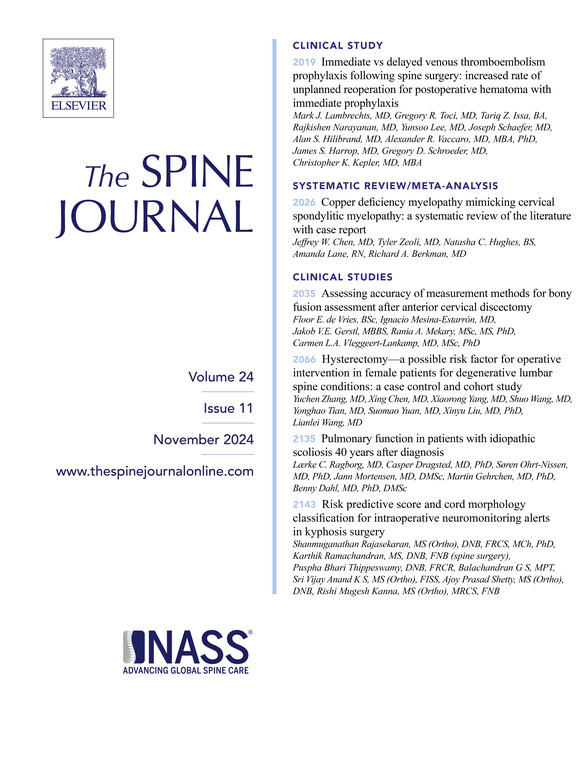The incidence, clinical features, and risk factors for postoperative retropharyngeal hematoma and related dyspnea following anterior cervical discectomy and fusion: a single-center study of 10,615 patients
IF 4.9
1区 医学
Q1 CLINICAL NEUROLOGY
引用次数: 0
Abstract
BACKGROUND CONTEXT
Postoperative retropharyngeal hematoma (PRH) and related dyspnea are rare but life-threatening complications following anterior cervical discectomy and fusion (ACDF) that require urgent recognition and treatment. However, current knowledge of PRH after ACDF is limited. Meanwhile, whether the morphological features of upper airway are the risk factors of PRH remains unknown.
PURPOSE
The study aimed to investigate the incidence, clinical features, and risk factors, especially the morphological features of upper airway, of PRH and related dyspnea following ACDF.
STUDY DESIGN
A nested case‒control study.
PATIENT SAMPLE
Consecutive patients who underwent ACDF at a single institute from January 2010 to December 2021 were retrospectively reviewed.
OUTCOME MEASURES
The outcome measures included the incidence, clinical features, intervention, outcome and risk factors for PRH and related dyspnea.
METHODS
All patients with PRH were classified into the hematoma group. For each PRH subject, 3 control subjects without PRH were randomly selected as the control group. The clinical features, interventions and outcomes of patients were described. Potential risk factors were evaluated, including demographics, comorbidities, surgical characteristics, coagulation function, blood loss, preoperative blood pressure, and the morphological features of upper airway [prevertebral soft tissue thickness (PVT) and location of transverse arytenoid muscle (TAM) and epiglottis]. Univariate tests and multivariable logistic regression analysis were used to determine the risk factors for PRH. Subgroup analysis was also conducted for PRH patients with and without dyspnea.
RESULTS
Among the 10615 patients who underwent ACDF, 18 (0.17%) developed PRH. The median time from the index surgery to PRH formation was 8.5 hours (25 and 75 percentile: 4 hours to 24 hours). All the PRH patients initially presented with wound swelling. Twelve (0.11%) patients presented dyspnea due to PRH, 2 of whom received urgent intubation and 1 of whom received emergent tracheotomy. All patients underwent hematoma evacuation, and most of them presented with completely relieved symptoms after evacuation, except for 1 patient who died from ischemic hypoxic encephalopathy. A level between the epiglottis and the TAM (LET) greater than 2, ossification of posterior longitudinal ligament (OPLL) and higher diastolic blood pressure (DBP) before surgery were found to be risk factors for PRH formation. Subgroup analysis revealed that a smaller prevertebral soft tissue thickness at C5 was associated with the development of dyspnea.
CONCLUSION
This study is the largest study to date focusing on the PRH and related dyspnea after ACDF. Our study showed that the incidences of PRH and related dyspnea after ACDF were 0.17% and 0.11%, respectively. The predominant symptoms of PRH were wound swelling and acute dyspnea. Most PRH cases occurred in the acute postoperative period. We demonstrated the risk factors for PRH to be (1) OPLL, (2) LET≥2 and (3) higher DBP before surgery and advocate paying increased attention to upper airway morphological features for identifying the risk of PRH after ACDF. With urgent recognition and timely intervention, severe clinical outcomes could be avoided.
颈椎前路椎间盘切除和融合术后咽后血肿及相关呼吸困难的发生率、临床特征和风险因素:对10615名患者进行的单中心研究。
背景情况:术后咽后血肿(PRH)和相关的呼吸困难是颈椎前路椎间盘切除和融合术(ACDF)后罕见但危及生命的并发症,需要紧急识别和治疗。然而,目前对 ACDF 术后 PRH 的了解还很有限。目的:本研究旨在探讨 ACDF 术后 PRH 及相关呼吸困难的发病率、临床特征、危险因素,尤其是上气道的形态特征:患者样本:回顾性研究:对 2010 年 1 月至 2021 年 12 月期间在一家研究所接受 ACDF 的连续患者进行回顾性研究:结果测量包括PRH和相关呼吸困难的发生率、临床特征、干预措施、结果和风险因素:所有 PRH 患者均被分为血肿组。方法:将所有 PRH 患者分为血肿组,每名 PRH 受试者随机抽取三名无 PRH 的对照受试者作为对照组。对患者的临床特征、干预措施和结果进行了描述。对潜在风险因素进行了评估,包括人口统计学、合并症、手术特征、凝血功能、失血量、术前血压以及上气道形态特征[椎前软组织厚度(PVT)、横杓状肌(TAM)和会厌的位置]。采用单变量检验和多变量逻辑回归分析来确定 PRH 的风险因素。还对有和无呼吸困难的 PRH 患者进行了分组分析:在接受 ACDF 治疗的 10615 例患者中,有 18 例(0.17%)出现 PRH。从指数手术到形成 PRH 的中位时间为 8.5 小时(25 和 75 百分位数:4 小时至 24 小时)。所有 PRH 患者最初都表现为伤口肿胀。12例(0.11%)患者因PRH出现呼吸困难,其中2例接受了紧急插管,1例接受了紧急气管切开术。除一名患者死于缺血缺氧性脑病外,所有患者均接受了血肿清除术,清除血肿后大部分患者症状完全缓解。会厌与 TAM 之间的水平(LET)大于 2、后纵韧带骨化(OPLL)和术前舒张压(DBP)较高被认为是 PRH 形成的危险因素。亚组分析显示,C5椎体前软组织厚度较小与呼吸困难的发生有关:本研究是迄今为止关于 ACDF 术后 PRH 及相关呼吸困难的最大规模研究。我们的研究表明,ACDF术后PRH和相关呼吸困难的发生率分别为0.17%和0.11%。PRH 的主要症状是伤口肿胀和急性呼吸困难。大多数 PRH 病例发生在术后急性期。我们证明了 PRH 的风险因素为:(1)OPLL;(2)LET≥2;(3)术前 DBP 较高,并提倡在 ACDF 术后识别 PRH 风险时应更加关注上呼吸道形态特征。通过紧急识别和及时干预,可以避免严重的临床后果。
本文章由计算机程序翻译,如有差异,请以英文原文为准。
求助全文
约1分钟内获得全文
求助全文
来源期刊

Spine Journal
医学-临床神经学
CiteScore
8.20
自引率
6.70%
发文量
680
审稿时长
13.1 weeks
期刊介绍:
The Spine Journal, the official journal of the North American Spine Society, is an international and multidisciplinary journal that publishes original, peer-reviewed articles on research and treatment related to the spine and spine care, including basic science and clinical investigations. It is a condition of publication that manuscripts submitted to The Spine Journal have not been published, and will not be simultaneously submitted or published elsewhere. The Spine Journal also publishes major reviews of specific topics by acknowledged authorities, technical notes, teaching editorials, and other special features, Letters to the Editor-in-Chief are encouraged.
 求助内容:
求助内容: 应助结果提醒方式:
应助结果提醒方式:


